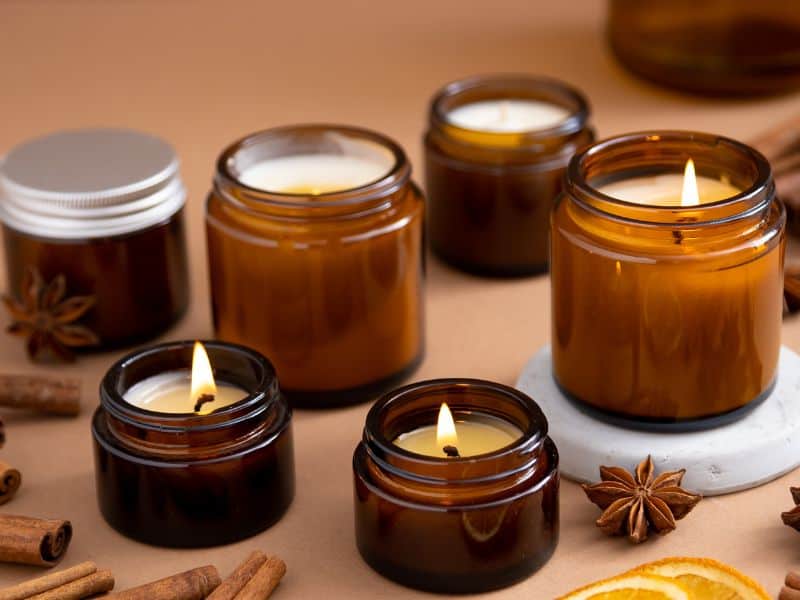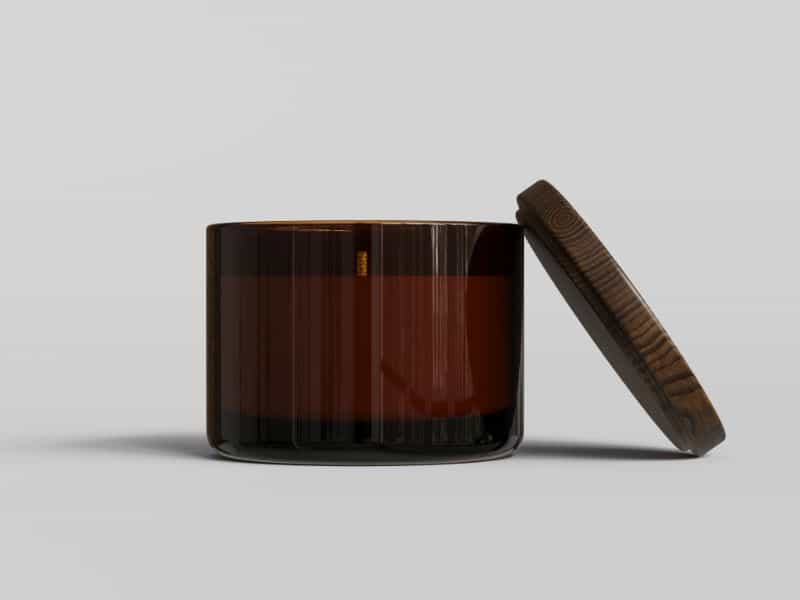If you’re a candle enthusiast looking to elevate your scent game, you’ve come to the right place. We will look at all of the issues that affect how strong your candles smell, allowing you to immerse yourself in delightful and enchanting aromas. So, how do you make candles smell stronger?
Make candles smell stronger by using quality fragrance oils, choosing the right wax with a lower melting point, matching candle size to the space, ensure proper wicking, curing the candles for an optimal duration, and storing them in a cool, dry place to preserve their fragrance potency.
Let’s delve into effective techniques for making candles with stronger scents. We’ll cover key aspects such as fragrance oils, wax selection, wicking, curing, and proper storage. Prepare to elevate your candle-making skills and create captivating fragrances that will transform your space.
Match Candles to the Space
The problem may be that you are not using enough candles for the room you are in. To ensure the fragrance fills the room adequately, it’s essential to consider the size of the space when selecting candles.
Using the correct number of candles for the room’s dimensions helps distribute the scent effectively. A larger room might require multiple candles or larger-sized candles, while a smaller space can be filled with a single well-chosen candle.
The number of candles needed per square foot depends on various factors, including the desired scent intensity, candle size, and the potency of the fragrance.
While there is no hard and fast rule, here are some general guidelines to help you determine the number of candles:
- For a small room or space (up to 100 square feet): One well-scented candle or a few tea-light candles can suffice to fill the area with a pleasant fragrance.
- For a medium-sized room (100-300 square feet): Consider using two to three medium-sized candles or a combination of larger and smaller candles to distribute the scent evenly.
- For a larger room (300+ square feet): Depending on the room’s dimensions and airflow, you may need multiple candles strategically placed throughout the space. Four or more candles, including larger ones, can help ensure the fragrance permeates the entire area.
You can adjust the number of candles based on your preference and the strength of the fragrance. It’s always a good idea to start with fewer candles and gradually increase the quantity if needed, allowing you to find the perfect balance of scent for your space.
Choosing Quality Fragrance Oils
The quality of fragrance oils significantly impacts the strength and longevity of the scent in your candles. Opt for high-quality fragrance oils that are specifically formulated for candle-making. Look for oils that have a strong scent throw and are designed to withstand the heat of the burning candle. Reading reviews and seeking recommendations from fellow candle makers can guide you towards reliable brands and suppliers.
When selecting fragrance oils, consider the desired scent intensity and the compatibility of the oil with your chosen wax type. Experimenting with different oils can help you find the perfect match for your desired scent profile. Additionally, prioritize oils that are phthalate-free and sourced from reputable suppliers to ensure a safe and pleasant candle experience.
Remember, the journey to creating candles with stronger scents involves understanding the fragrance world, matching candles to the space, and selecting high-quality fragrance oils. Stay tuned for the following sections, where we will delve deeper into wax selection, fragrance load, proper wicking, and more.
Store Candles Properly
Curing, also known as the “resting period,” is an essential step in candle-making that allows the fragrance to fully develop and strengthen. During the curing process, the fragrance oils and wax blend harmoniously, resulting in a more potent scent. Here’s what you need to know:
- Patience is key: Curing time can vary depending on the type of wax and fragrance used. In general, most candles benefit from a curing period of at least 48 hours up to two weeks or more. Be sure to check the recommended curing time specified by the wax and fragrance manufacturers.
- Proper airflow: During the curing process, it’s crucial to provide adequate airflow around the candles. Avoid sealing them in airtight containers or wrapping them tightly. Instead, place them in a well-ventilated area, allowing the scent to develop naturally.
Curing Candles Properly
The melting point of your candle wax plays a significant role in scent release and overall performance. Here’s what you need to know to ensure a strong scent:
- Choose the right wax: Different wax types have varying melting points. Opt for waxes that have lower melting points if you want a stronger scent throw. Soy wax, for example, tends to have a lower melting point compared to paraffin wax.
- Melting temperature: When melting your wax, it’s essential to maintain a suitable temperature. Follow the manufacturer’s instructions for the specific wax you’re using. Heating the wax too quickly or at high temperatures can cause fragrance evaporation, resulting in a weaker scent.
- Stirring and blending: Properly stirring your fragrance oils into the melted wax ensures an even distribution of scent throughout the candle. Take care not to stir too vigorously, as it can introduce air bubbles that may affect the overall quality of the candle.
With attention to storage, the benefits of curing, and understanding melting points, you can troubleshoot scent strength issues and create captivating candles. Stay tuned for the next sections, where we’ll delve deeper into wax selection, fragrance load, proper wicking, and more scent-enhancing techniques.
Correct Melting Points
The melting point of candle wax is crucial for achieving optimal scent throw. Consider the following points:
- Why correct wicking matters: Using the appropriate wick size ensures a controlled and consistent burn. It helps maintain the right temperature for the wax to release its fragrance effectively.
- How it affects scent throw: A wick that is too small may not create enough heat to fully melt the wax, resulting in a weak scent throw. Conversely, an oversized wick can lead to excessive heat, causing the fragrance to burn off quickly without fully dispersing.
Proper Wicking
Proper wicking is essential to maximize the scent experience in your candles. Here’s what you need to know:
- What’s fragrance load? The fragrance load refers to the amount of fragrance oil used in relation to the amount of wax in a candle. It determines the strength of the scent when the candle is burned.
- Its role in scent strength: Increasing the fragrance load can intensify the scent in your candles. However, it’s crucial to maintain a balance to prevent overpowering fragrances or issues with candle performance.
Fragrance Load
The choice of wax has a direct influence on the scent performance of your candles. Consider the following factors:
- How wax type impacts scent: Different wax types have varying abilities to hold and release fragrance. For instance, soy wax is known for its excellent scent throw, while beeswax has a natural, subtle fragrance.
- Best waxes for strong scents: If you aim for powerful fragrance, consider using soy wax, coconut wax, or a blend specifically designed for scent intensity. These waxes have excellent fragrance retention properties and can enhance the overall scent experience.
Wax Selection
Choosing the appropriate wax is crucial for achieving the desired scent strength. Here are some factors to consider:
- Consider your goals: Determine the desired scent intensity and the type of fragrance you want to achieve. This will guide you in selecting the appropriate wax type.
- Experimentation and research: Test different waxes to see which ones deliver the desired scent throw. Research various wax options, read reviews, and seek recommendations from experienced candle makers to make an informed decision.
Understanding correct melting points, the importance of proper wicking, fragrance load, and the impact of wax selection enables you to optimize the scent strength in your candles. In the following sections, we will delve into selecting quality fragrance oils, maximizing scent with additives, and exploring scent combinations to further enhance the aroma of your candles.
Troubleshooting Scent Strength Issues
The way you store your candles plays a crucial role in maintaining their scent strength over time. Improper storage can result in fragrance degradation or the absorption of unwanted odors. To ensure optimal scent strength, it’s essential to follow these best practices:
- Store candles in a cool, dry place: Heat and humidity can cause fragrance oils to break down, leading to a weakened scent. To preserve the integrity of the fragrance, select a storage area that is cool and free from excess moisture. A closet or drawer away from direct sunlight is an ideal choice.
- Use airtight containers or packaging: Candles can easily absorb surrounding odors, compromising their intended fragrance. To prevent this, store your candles in airtight containers or resealable bags. This creates a barrier that protects the candles from external odors and helps maintain a fresh scent until you’re ready to use them.
- Separate different scented candles: When storing multiple scented candles, it’s best to keep them apart to prevent cross-contamination of fragrances. This ensures that each candle maintains its unique scent profile.
Adhering to proper storage practices, such as storing candles in a cool, dry place and using airtight containers, can help you can help preserve the fragrance integrity and enjoy stronger scents when you light your candles.
Frequently Asked Questions
Fragrance oils are essential for adding desired scents to candles and boosting their fragrance strength.
When selecting fragrance oils, consider their compatibility with your wax, desired scent intensity, and recommendations from reputable suppliers.
Different waxes have varying abilities to hold and release fragrance, making the choice of wax type crucial for scent strength.
Proper wicking ensures a controlled and consistent burn, allowing the wax to melt evenly and release fragrance effectively.
Absolutely! Mixing and matching scents can create delightful and personalized fragrance combinations for your candles.
Yes, certain additives can act as scent boosters and enhance the fragrance potency of your candles. Ensure they are safe and compatible with your wax type.
Conclusion
In conclusion, by implementing the techniques and insights shared in this article, you have the power to take your candle-making and scent-enhancing abilities to new heights.
Understanding the role of fragrance oils, selecting the right wax, mastering wicking techniques, and optimizing curing and storage practices will enable you to create candles with captivating and stronger scents. Let your creativity soar as you infuse your space with delightful fragrances that enchant and uplift the senses.






